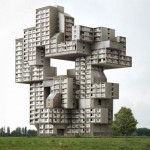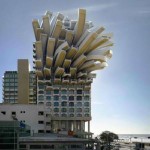Recently, Jared Polin of Fro Knows Photo released a video showing images shot with the Sony a9 and 70-200mm F2.8 GM lens that displayed visible banding across parts of the image in 2% of his shots from a recent soccer match in Philadelphia.* Here’s what the banding looks like at 100%:
 |
| This is a 100% crop of the Sony a9 banding issues that Jared Polin noticed in a small portion of his shots of sideline players at a recent soccer match. The bands themselves are 84 pixels in height, each composed of 7 12-pixel bands. Read on to understand why those numbers are significant when it comes to explaining the phenomenon.
Photo: Jared Polin |
Blame the electronic shutter?
Not so fast. Some commenters were quick to blame artificial stadium lighting, which can of course interfere with electronic shutters. However, the a9’s electronic shutter is no ordinary electronic shutter: it can scan across the entire sensor in a mere 1/160s (proven by our friend, and well-respected forum member, Jim Kasson here). What does that mean? Meanwhile, the a9’s mechanical shutter isn’t actually much faster – it takes 1/300s to sweep across the image plane.** That means that in typical artificial lighting, which tends to flicker at 60 or 120 Hz, the 1/160s shutter rate of the a9 is fast enough that it’ll only ever really see 1 or 1.3 pulses of the flickering light as the sensor is scanned. The a9’s electronic shutter is only one stop away from catching up to mechanical shutters.
This means that even in the worst artificially-lit scenarios, you might see one large diffuse band across your image at very high shutter speeds (remember: shutter speed determines the intensity of such bands), but generally you’re unlikely to notice if just a quarter of your image happens to have a slight roll-off to a dimmer – or brighter – exposure.
In other words, in the real-world, artifacts caused by the a9’s electronic shutter are rarely an issue under dominant artificial lighting. Furthermore, in this example the match was being played in a mixture of natural and artificial light, with natural light being dominant.
So what caused the banding?
A closer look at the LED advertising boards
Look closely at the image above at 100%, and you’ll see the larger bands themselves are composed of bands 12-pixels high. 12-pixels… rings a bell. Jim Kasson’s work suggested the a9 reads its sensor out in 12-row chunks, possibly by using 12 parallel ADCs (analog-to-digital converters). That’s how it can scan across its entire full-frame sensor so quickly. This suggests the sensor readout is somehow implicated – but how?
Take a close look at the LED advertising boards at 100%:
 |
|
A shot of the LED advertising boards clearly implicate them as the source of the banding. Each one of those aliased bands are 12 pixels high, and we know from Jim Kasson’s studies that the a9 reads it sensor out in 12-row chunks, using 12 parallel ADCs.
Photo: Jared Polin
|
The one thing common to Jared’s 2% of images is that the players are at least partially lit by the LED advertising boards on the sidelines. Those panels create an image by rapidly pulsing their red, green, and blue LEDs to allow for different colors and brightness, and it’s the first type of light source we’ve seen that has caused the a9 any grief.
And by rapid switching we do mean rapid. The larger bands are 84 pixels in height, meaning there are about 48 of them across the entire 4000 pixel-high image. Since we know that full sensor readout takes 1/160s, that means those LEDs pulsed 48 cycles in 6.25 milliseconds, or at a frequency of ~7700 Hz.
Even a mechanical focal plane shutter will experience this kind of banding with a light source cycling 7700 times a second. However, the a9’s banding is worse for two reasons:
- A mechanical shutter would take half as much time traversing the image plane, which means half as many bands (probably 24 larger bands would show up in these sorts of images).
- The a9’s electronic shutter proceeds in 12-row chunks; a mechanical shutter is more analogous to an electronic shutter proceeding line by line, which would yield smoother bands. Not the more hard-edged, lower frequency (and therefore more readily identifiable) 12-row bands that are visually more distracting than if they had been gradual, single-pixel rows transitioning from one color or brightness to another.
This is the reason why Fro only sees banding in some of his photos, and why even in those it is limited to certain surfaces. The bands are most prominent wherever the LED boards were lending the most light to the subject.
Is it a big deal?
So does this matter? Is it as big a deal as some people are making it out to be?
That all depends on how often you expect to run into this situation. These types of LED lights are relatively rare—basically only appearing in scoreboards and ad boards of the kind you see at sporting events. And even when they’re present, the board has to be casting a significant amount of light on your subject for it to cause any problems.
Furthermore, your shutter speed has to be extremely high to make these bands prominent, and even mechanical shutters are likely not entirely immune to some effect from such LED boards.
 |
|
Even at an image level, the 84-pixel wide bands can be visually distracting if the LED boards are a dominant source of illumination for your (sideline) subject.
Photo: Jared Polin
|
All those considerations taken together explain why Fro only found banding in about 50 of the 1,905 images he shot.
If you scrolled down here to the bottom to get the definitive answer to the source and cause of the banding, it’s this: very high frequency (>7000Hz) flickering LEDs combined with the 12-row parallel readout that allows the electronic shutter of the a9 to achieve almost mechanical shutter speeds.
Granted, as a camera designed (partly) to satisfy the needs of sports photographers, the a9 is probably going to be found shooting in situations with LED signboards around where, after-hours, they might account for a significant portion of light on your sideline subjects. If that describes the situations you’ll be routinely shooting under, and you’re concerned about the 2% banding rate in sideline action, this may be something to add to your ‘cons’ list when considering this camera.
*Note this is a different sort of banding than the rare striping we investigated in our full review (that results from the masked phase-detection rows of pixels).
**Compare that to the a7R II’s 1/14s, or the Fuji GFX 50S’ 1/4s, electronic or ‘silent’ shutters.
Articles: Digital Photography Review (dpreview.com)




















































You must be logged in to post a comment.